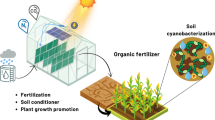Summary
CO2 exchange, the diurnal variations in the levels of malic, citric and isocitric acid, and the labelling pattern after 14CO2 fixation were measured in Sedum acre and Sedum mite growing in situ. As predicted from laboratory experiments, drought changed the gas exchange pattern from a C3 type to a crassulacean acid metabolism (CAM) type. This shift correlated with the development of a diurnal rhythm in the malic acid content. The results of 14CO2 pulse-chase experiments suggest that in well-watered plants a CAM pattern of carbon flow already exists; hence water stress might enhance latent CAM rather than induce it. The in situ CAM performance by the Sedum species appeared to be highly susceptible to modulation by season and external factors, particularly light and temperature.
CAM did not substantially contribute to total carbon gain in S. acre and S. mite. During most of their lifecycles the plants grow under conditions that favour CO2 uptake by the C3 pathway rather than by CAM. Hence, despite a capability to feature CAM, the δ13C values found in S. acre and S. mite are those of C3 plants.
Similar content being viewed by others
Abbreviations
- CAM:
-
Crassulacean Acid Metabolism
- PEP-C:
-
Phosphoenolpyruvate-Carboxylase
- DW:
-
Dry weight
References
Böcher M, Kluge M (1977) The C4-pathway of C-fixation in Spinacea oleracea. I. 14C-labelling pattern of suspended leaf slices as influenced by the external medium. Zeitschrift für Pflanzenphysiologie 83:347–361
Dagley S (1970) Citrat. UV-spektrophotometrische Bestimmung. In: HU Bergmeyer (ed), Methoden der enzymatischen Analyse. Verlag Chemie, Weinheim/Bergstraße p 1520–1523
Hohorst H-J (1970) L-(-)-Malat-Bestimmung mit Malatdehydrogenase und NAD. In: HU Bergmeyer (ed), Methoden der enzymatischen Analyse. Verlag Chemie, Weinheim/Bergstraße p 1544–1548
Kluge M (1977) Is Sedum acre a CAM plant? Oecologia 29:77–83
Kluge M (1978) Ecological aspects of Crassulacean Acid Metabolism (CAM). In: DO Hall, J Coombs and TW Goodwin (eds), Proceedings of the Fourth International Congress on Photosynthesis. The Biochemical Society, London p 335–345
Kluge M (1979) Crassulacean Acid Metabolism (CAM): Einige stoffwechselphysiologische und ökologische Aspekte. Ber Deutsch Bot Ges 92:95–107
Knopf O, Kluge M (1979) Properties of phosphoenol pyruvate carboxylase in Sedum species in relation to Crassulacean Acid Metabolism. Plant Cell and Environment 2:73–78
Lange OL, Schulze BD, Kappen, L, Evenari M, Buschbom U (1975) CO2 exchange pattern under natural conditions of Caralluma negevensis, a CAM plant of the Negev Desert. Photosynthetica 9:318–326
Osmond, CB, Ziegler H, Stichler W, Trimborn P (1975) Carbon isotope discrimination in alpine succulent plants supposed to be capable of Crassulacean Acid Metabolism (CAM). Oecologia (Berl) 18:209–217
Raschke K (1975) Stomatal action. Ann Rev Plant Physiol 26:309–340
Schuber M, Kluge M (1979) Crassulaceen-Säurestoffwechsel (CAM) bei mitteleuropäischen Sukkulenten. Ökologische Untersuchungen an Sempervivum-Arten. Flora 168:205–216
Schulze ED (1972) A new type of climatized gas exchange chamber for net photosynthesis transpiration measurements in the field. Oecologia 10:243–251
Siebert G (1970) Isocitrat. UV-spektrophotometrische Bestimmung. In: HU Bergmeyer (ed), Methoden der enzymatischen Analyse, Verlag Chemie Weinheim/Bergstraße p 1528–1531
Steudle E, Smith JAC, Lüttge U (1980) Water relation parameters of individual mesophyll cells of the Crassulacean Acid Metabolism plant Kalanchae daigremontiana. Plant Physiol 66:1155–1163
Stocker O (1929) Eine Feldmethode zur Bestimmung der momentanen Transpirations- und Evaporationsgröße. I und II. Ber Deutsch Bot Ges 47:126–136
Winter K, Lüttge U (1979) C3-Photosynthese und Crassulaceen-Säurestoffwechsel bei Mesembryanthemum crystallinum. Ber Deutsch Bot Ges 92:117–132
Winter K, von Willert DJ (1972) NaCl-induzierter Crassulaceen-Säurestoffwechsel bei Mesembryanthemum crystallinum. Biochim Biophys Acta 343:465–468
Author information
Authors and Affiliations
Additional information
Dedicated to Prof. Dr. Dr. h.c. M. Evenari on the occasion of his 75th birthday and to Dr. K.F. Springer
Rights and permissions
About this article
Cite this article
Schuber, M., Kluge, M. In situ studies on crassulacean acid metabolism in Sedum acre L. and Sedum mite Gil. Oecologia 50, 82–87 (1981). https://doi.org/10.1007/BF00378797
Received:
Issue Date:
DOI: https://doi.org/10.1007/BF00378797




